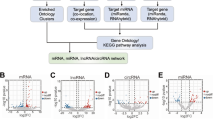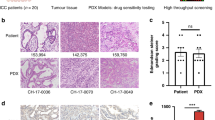Abstract
Purpose
The anti-prostate cancer drug flutamide occasionally causes hepatotoxicity, and predictive biomarkers of flutamide-induced liver injury (FILI) are needed to improve safety of this drug. The aim of this prospective study was to identify such a biomarker by analyzing peripheral blood samples from patients before flutamide therapy.
Methods
Blood samples were obtained from 52 patients with prostate cancer before flutamide therapy. FILI was defined as treatment-related elevation of the serum concentration of aspartate or alanine aminotransferase to more than twice the upper limit of the reference range. The patients were monitored for at least 6 months regarding FILI. Microarray and quantitative real-time PCR analyses were conducted to compare gene expression profiles between the groups with and without FILI.
Results
Seventeen patients developed FILI. Microarray analysis of the training set in 15 patients detected 11 annotated genes showing >twofold expression changes between the groups (p < 0.005). Quantitative PCR analysis of both the training set and validation set confirmed that mRNA levels of multidrug and toxin extrusion protein 1 (MATE1 or SLC47A1, encoded by 1 of the 11 genes) were significantly lower in patients with FILI. A small experiment on mice (three per group) showed that Mate1 knockout mice had an elevated serum concentration of 4-nitro-3-(trifluoromethyl)phenylamine, a major metabolite of flutamide, 2 h after administration of the drug, suggesting that Mate1 could affect the pharmacokinetics of flutamide.
Conclusions
The MATE1 mRNA level in peripheral blood is a possible negative predictive biomarker of FILI.



Similar content being viewed by others
Abbreviations
- ALT:
-
Alanine aminotransferase
- AST:
-
Aspartate aminotransferase
- FILI:
-
Flutamide-induced liver injury
- FLU-1:
-
4-Nitro-3-(trifluoromethyl)phenylamine
- MATE1:
-
Multidrug and toxin extrusion protein 1
- SLC47A1:
-
Solute carrier family 47 (multidrug and toxin extrusion), member 1
- SNP:
-
Single nucleotide polymorphism
References
Crawford ED, Eisenberger MA, McLeod DG, Spaulding JT, Benson R, Dorr FA, Blumenstein BA, Davis MA, Goodman PJ (1989) A controlled trial of leuprolide with and without flutamide in prostatic carcinoma. N Engl J Med 321:419–424
Prostate Cancer Trialists’ Collaborative Group (2000) Maximum androgen blockade in advanced prostate cancer: an overview of the randomised trials. Lancet 355:1491–1498
Kojima S, Suzuki H, Akakura K, Shimbo M, Ichikawa T, Ito H (2004) Alternative antiandrogens to treat prostate cancer relapse after initial hormone therapy. J Urol 171:679–683
Suzuki H, Okihara K, Miyake H, Fujisawa M, Miyoshi S, Matsumoto T, Fujii M, Takihana Y, Usui T, Matsuda T, Ozono S, Kumon H, Ichikawa T, Miki T (2008) Alternative nonsteroidal antiandrogen therapy for advanced prostate cancer that relapsed after initial maximum androgen blockade. J Urol 180:921–927
Cetin M, Demirci D, Unal A, Altinbas M, Guven M, Unluhizarci K (1999) Frequency of flutamide induced hepatotoxicity in patients with prostate carcinoma. Hum Exp Toxicol 18:137–140
Thole Z, Manso G, Salgueiro E, Revuelta P, Hidalgo A (2004) Hepatotoxicity induced by antiandrogens: a review of the literature. Urol Int 73:289–295
Wysowski DK, Fourcroy JL (1996) Flutamide hepatotoxicity. J Urol 155:209–212
Osculati A, Castiglioni C (2006) Fatal liver complications with flutamide. Lancet 367:1140–1141
Wada T, Ueda M, Abe K, Kobari T, Yamazaki H, Nakata J, Ikemoto I, Ohishi Y, Aizawa Y (1999) Risk factor of liver disorders caused by flutamide—statistical analysis using multivariate logistic regression analysis. Hinyokika Kiyo 45:521–526
Uetrecht J (2002) N-oxidation of drugs associated with idiosyncratic drug reactions. Drug Metab Rev 34:651–665
Ozono S, Yamaguchi A, Mochizuki H, Kawakami T, Fujimoto K, Otani T, Yoshida K, Ichinei M, Yamashita T, Hirao Y (2002) Caffeine test in predicting flutamide-induced hepatic injury in patients with prostate cancer. Prostate Cancer Prostatic Dis 5:128–131
Devouassoux G, Pachot A, Laforest L, Diasparra J, Freymond N, Van Ganse E, Mougin B, Pacheco Y (2008) Galectin-10 mRNA is overexpressed in peripheral blood of aspirin-induced asthma. Allergy 63:125–131
Huang T, Tu K, Shyr Y, Wei CC, Xie L, Li YX (2008) The prediction of interferon treatment effects based on time series microarray gene expression profiles. J Transl Med 6:44
Matsuoka H, Arao T, Makimura C, Takeda M, Kiyota H, Tsurutani J, Fujita Y, Matsumoto K, Kimura H, Otsuka M, Koyama A, Imamura CK, Tanigawara Y, Yamanaka T, Tanaka K, Nishio K, Nakagawa K (2012) Expression changes in arrestin beta 1 and genetic variation in catechol-O-methyltransferase are biomarkers for the response to morphine treatment in cancer patients. Oncol Rep 27:1393–1399
Tsuda M, Terada T, Mizuno T, Katsura T, Shimakura J, Inui K (2009) Targeted disruption of the multidrug and toxin extrusion 1 (mate1) gene in mice reduces renal secretion of metformin. Mol Pharmacol 75:1280–1286
Yonezawa A, Inui K (2011) Importance of the multidrug and toxin extrusion MATE/SLC47A family to pharmacokinetics, pharmacodynamics/toxicodynamics and pharmacogenomics. Br J Pharmacol 164:1817–1825
Otsuka M, Matsumoto T, Morimoto R, Arioka S, Omote H, Moriyama Y (2005) A human transporter protein that mediates the final excretion step for toxic organic cations. Proc Natl Acad Sci USA 102:17923–17928
Tanihara Y, Masuda S, Sato T, Katsura T, Ogawa O, Inui K (2007) Substrate specificity of MATE1 and MATE2-K, human multidrug and toxin extrusions/H(+)-organic cation antiporters. Biochem Pharmacol 74:359–371
Becker ML, Visser LE, van Schaik RH, Hofman A, Uitterlinden AG, Stricker BH (2009) Genetic variation in the multidrug and toxin extrusion 1 transporter protein influences the glucose-lowering effect of metformin in patients with diabetes: a preliminary study. Diabetes 58:745–749
Toyama K, Yonezawa A, Masuda S, Osawa R, Hosokawa M, Fujimoto S, Inagaki N, Inui K, Katsura T (2012) Loss of multidrug and toxin extrusion 1 (MATE1) is associated with metformin-induced lactic acidosis. Br J Pharmacol 166:1183–1191
Aizawa Y, Ikemoto I, Kishimoto K, Wada T, Yamazaki H, Ohishi Y, Kiyota H, Furuta N, Suzuki H, Ueda M (2003) Flutamide-induced hepatic dysfunction in relation to steady-state plasma concentrations of flutamide and its metabolites. Mol Cell Biochem 252:149–156
Kajiwara M, Terada T, Ogasawara K, Iwano J, Katsura T, Fukatsu A, Doi T, Inui K (2009) Identification of multidrug and toxin extrusion (MATE1 and MATE2-K) variants with complete loss of transport activity. J Hum Genet 54:40–46
Ha Choi J, Wah Yee S, Kim MJ, Nguyen L, Ho Lee J, Kang JO, Hesselson S, Castro RA, Stryke D, Johns SJ, Kwok PY, Ferrin TE, Goo Lee M, Black BL, Ahituv N, Giacomini KM (2009) Identification and characterization of novel polymorphisms in the basal promoter of the human transporter, MATE1. Pharmacogenetics Genomics 19:770–780
Acknowledgments
We are grateful to Mrs. Hisae Shiokawa and Dr. Hidetoshi Tsuda for technical assistance and to Dr. Kenji Komatsu, Dr. Takeshi Koshimizu, Dr. Shinsuke Natsui, Dr. Kazumi Suzuki, Dr. Masayuki Yuzawa, and Dr. Minoru Kobayashi for collecting patients’ data. We also thank all the participants for their cooperation. This work was supported by a grant from the Ministry of Health, Labor, and Welfare of Japan (H20-BIO-G-003).
Conflict of interest
The authors declare that they have no conflict of interest.
Author information
Authors and Affiliations
Corresponding author
Additional information
Kazuhiko Nakano and Hitoshi Ando have contributed equally to this study.
Rights and permissions
About this article
Cite this article
Nakano, K., Ando, H., Kurokawa, S. et al. Association of decreased mRNA expression of multidrug and toxin extrusion protein 1 in peripheral blood cells with the development of flutamide-induced liver injury. Cancer Chemother Pharmacol 75, 1191–1197 (2015). https://doi.org/10.1007/s00280-015-2743-6
Received:
Accepted:
Published:
Issue Date:
DOI: https://doi.org/10.1007/s00280-015-2743-6




